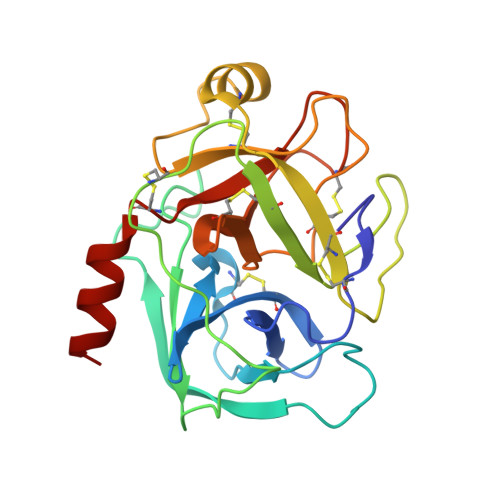Recruiting Zn2+ to mediate potent, specific inhibition of serine proteases.
Katz, B.A., Luong, C.(1999) J Mol Biol 292: 669-684
- PubMed: 10497030
- DOI: https://doi.org/10.1006/jmbi.1999.3071
- Primary Citation of Related Structures:
1C1S - PubMed Abstract:
As regulators of ubiquitous biological processes, serine proteases can cause disease states when inappropriately expressed or regulated, and are thus rational targets for inhibition by drugs. Recently we described a new inhibition mechanism applicable for the development of potent, selective small molecule serine protease inhibitors that recruit physiological Zn2+ to mediate high affinity (sub-nanomolar) binding. To demonstrate some of the structural principles by which the selectivity of Zn2+-mediated serine protease inhibitors can be developed toward or against a particular target, here we determine and describe the structures of thrombin-BABIM-Zn2+, -keto-BABIM-Zn2+, and -hemi-BABIM-Zn2+ (where BABIM is bis(5-amidino-2-benzimidazolyl)methane, keto-BABIM is bis(5-amidino-2-benzimidazolyl)methane ketone, and hemi-BABIM is (5-amidino-2-benzimidazolyl)(2-benzimidazolyl)methane), and compare them with the corresponding trypsin-inhibitor-Zn2+ complexes. Inhibitor binding is mediated by a Zn ion tetrahedrally coordinated by two benzimidazole nitrogen atoms of the inhibitor, by N(epsilon2)His57, and by O(gamma)Ser195. The structures of Zn2+-free trypsin-BABIM and -hemi-BABIM were also determined at selected pH values for comparison with the corresponding Zn2+-mediated complexes. To assess some of the physiological parameters important for harnessing Zn2+ as a co-inhibitor, crystal structures at multiple pH and [Zn2+] values were determined for trypsin-keto-BABIM. The Kdvalue of Zn2+ for the binary trypsin-keto-BABIM complex was estimated to be <12 nM at pH 7.06 by crystallographic determination of the occupancy of bound Zn2+ in trypsin-keto-BABIM crystals soaked at this pH in synthetic mother liquor containing inhibitor and 100 nM Zn2+. In synthetic mother liquor saturated in Zn2+, trypsin-bound keto-BABIM is unhydrated at pH 9.00 and 9.93, and has an sp2 hybridized ketone carbon bridging the 5-amidinobenzimidazoles, whereas at pH 7.00 and 8.00 it undergoes hydration and a change in geometry upon addition of water to the bridging carbonyl group. To show how Zn2+ could be recruited as a co-inhibitor of other enzymes, a method was developed for locating in protein crystals Zn2+ binding sites where design of Zn2+-mediated ligands can be attempted. Thus, by soaking trypsin crystals in high concentrations of Zn2+ in the absence of a molecular inhibitor, the site where Zn2+ mediates binding of BABIM and analogs was identified, as well as another Zn2+ binding site.
Organizational Affiliation:
Axys Pharmaceutical Corporation, 385 Oyster Point Boulevard, South San Francisco, CA 94080, USA. bak@axyspharm.com


















